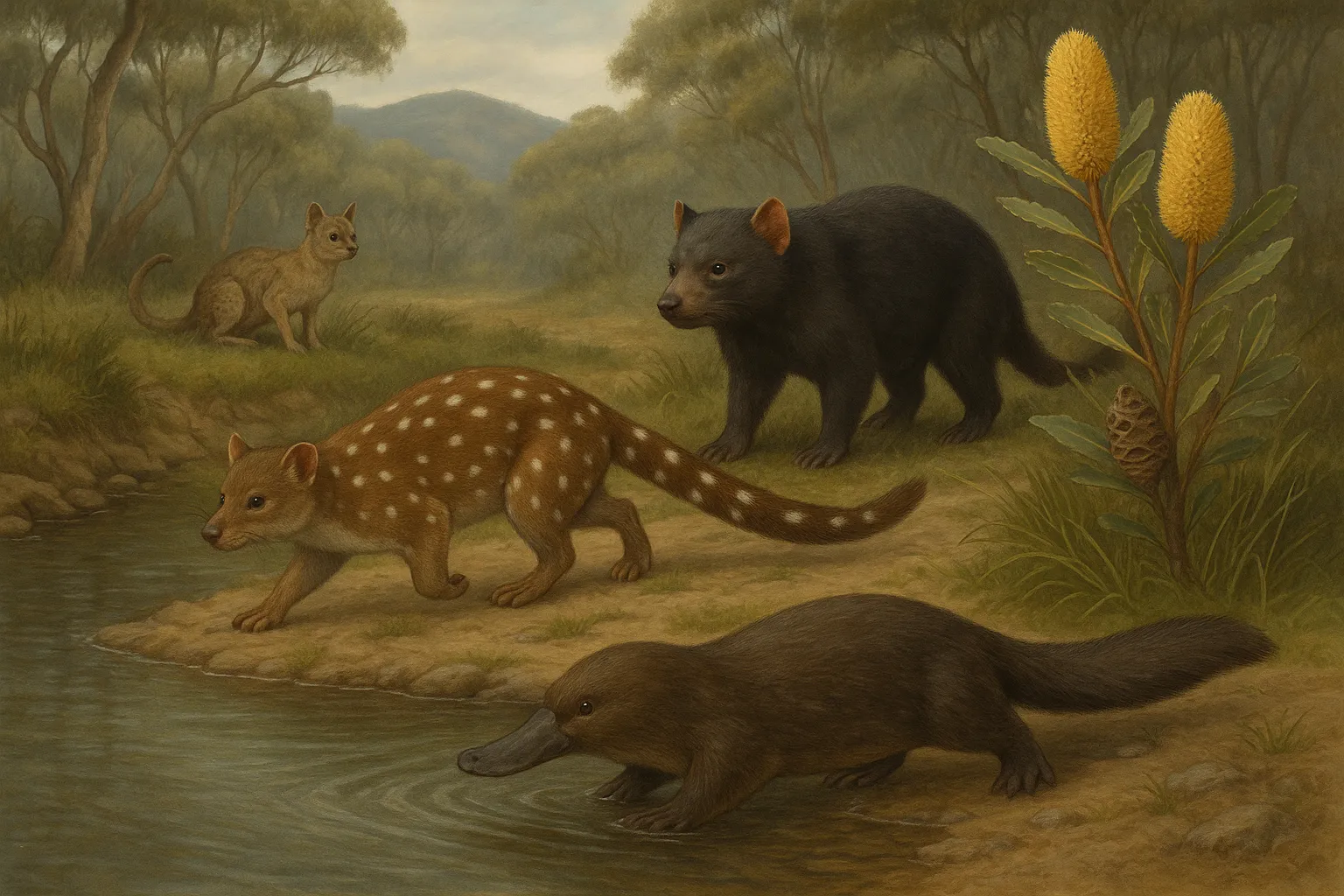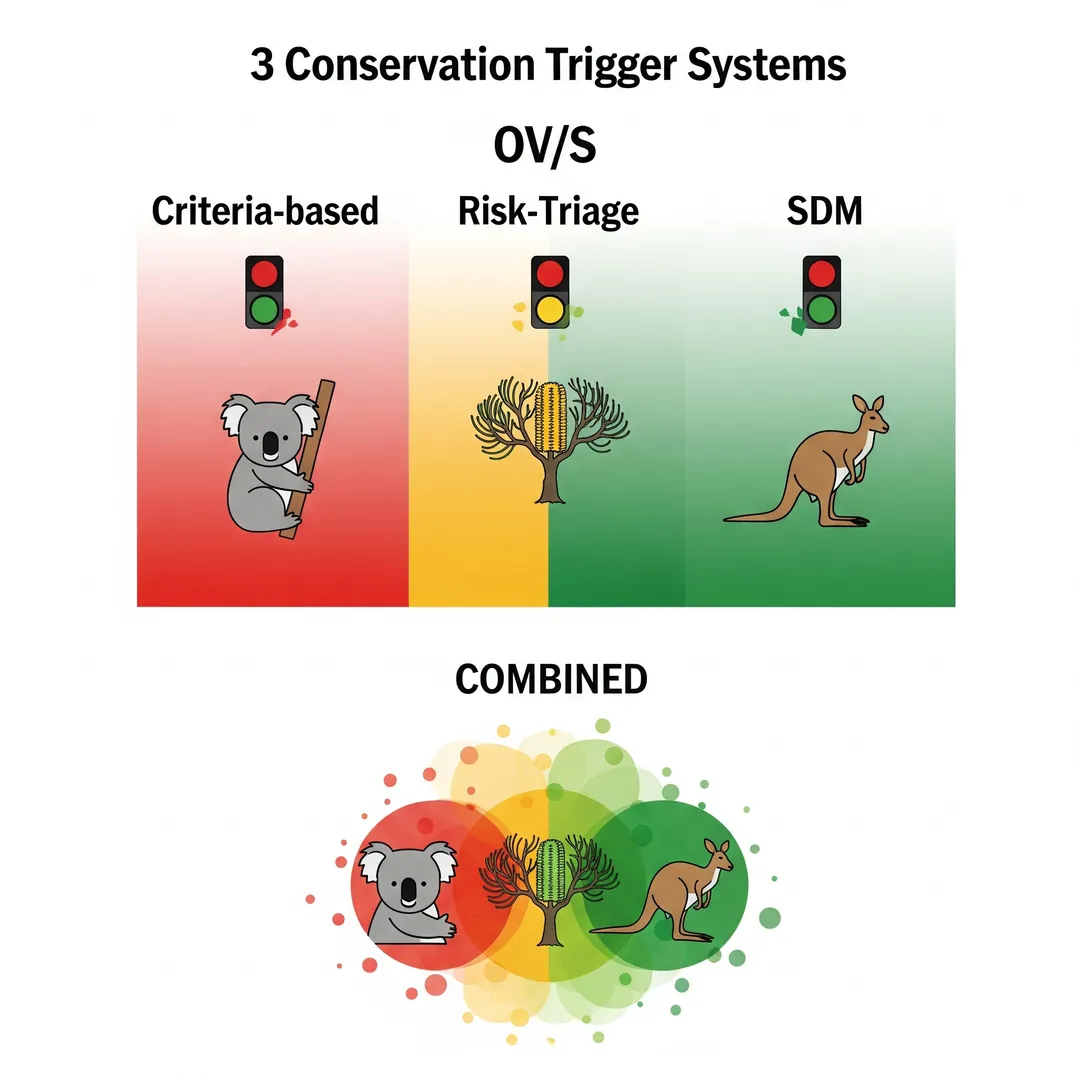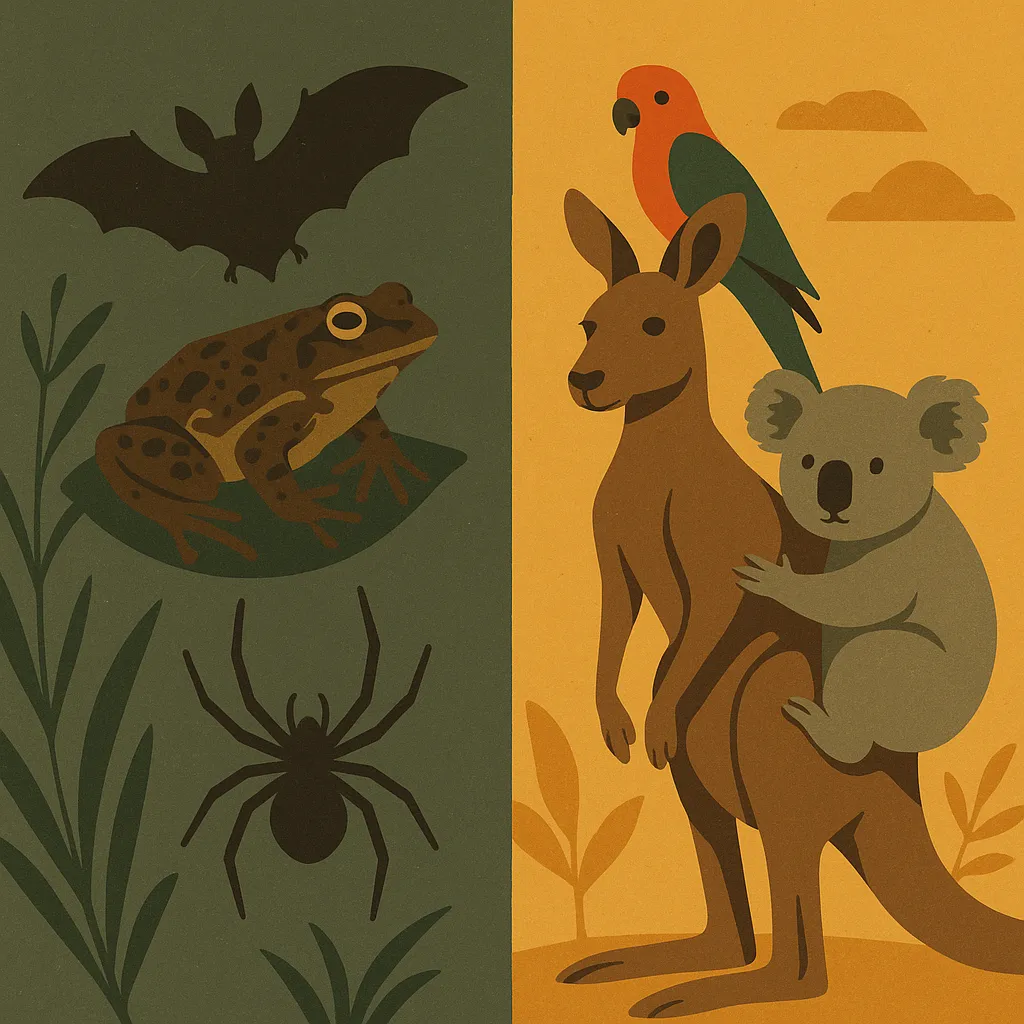Mate, Your Quoll is a Cat: Why Australian Wildlife ID Starts with the Landscape 🏞️
“Mate, your quoll is a cat.”
That’s what Maya said at 5:42 a.m., while I was shin-deep in a freezing Tasmanian creek, trying to catch the faint bow-wave of a Platypus at first light. We were meant to be finalising a crisp, practical ID guide for iconic Aussie species, but our test readers kept mixing up Quolls and feral cats on night cameras. My neat outlines were starting to look totally naïve.
I splashed to the bank and peered at her phone. The tail looked right—long, robust, dappled—classic Spotted-tailed Quoll. But the gait was wrong, the shoulder line too smooth. “You’re kidding,” I muttered. “Another false positive.”
If our own field crew miscalls it, imagine a visitor on a cold, rainy night. I’d built the draft around neat features—coat, tail, spots—assuming people would check the habitat after the excitement of a sighting. That morning, I realised the order was backwards. For most Aussie animals, you don’t see the whole beast first. You see the context. You feel the landscape. That’s where the identification starts.
We drove, heater blasting, and rewired the whole approach. We led with habitat cues and life-history tells, then used those to anchor the identification. We tested everything in the messiest conditions possible. (For the full tech and policy wrap-up on AI camera audits and eDNA, check out Secure Australia’s Wildlife: Proven 2025 Tech & Policy.)
The Week I Re-Learned How to “See” Australia’s Icons
Across eight humbling days last winter, we hit the Derwent catchment in lutruwita/Tasmania, the wet forests of north-east NSW, and finally the Banksia country of south-west WA. Field identification isn’t about memorizing features—it’s about reading landscapes like a detective reads crime scenes. Every creek, every fallen log, every soil type tells you what’s possible before you even lift your binos.
1. Platypus: Beyond the ‘Periscope’ – Seeing with Electricity ⚡
I’d told a group of Year 8s, “Watch for the ‘periscope’—a brief bill and ripples.” A sharp kid asked, “How’s it breathe with its nose shut underwater?” Great question. The monotreme playbook is wild: the Platypus shuts its senses underwater and “sees” prey through electrolocation with that rubbery bill. It feels electricity in shrimp muscles like we feel a phone vibration.
The Insider Secret Most Guides Miss: Platypus behaviour changes with water temperature and flow. In water below 10°C, they surface more frequently and stay closer to banks for warmth. This knowledge transforms your viewing success rate from a fluke to a near certainty.
- Identification Insight: Look for a V-shaped wake and neat, unhurried ripples, a brief roll of the back, then—poof—gone. Anything splashy is likely a water rat.
- Hidden Danger: Male Platypus have a venomous spur on the hind foot, most active in breeding season (July-October), causing severe, long-lasting pain. Never handle them—it’s illegal and unsafe.
- Habitat Essentials: Cool-to-temperate freshwaters in Eastern Australia and Tasmania with stable banks and invertebrate-rich beds. They are highly sensitive to water quality and drought stress.
- Conservation Win: The ban on “Opera-house” yabby traps has reduced drowning deaths significantly.
Try this and see the difference: Focus on transition zones where fast water meets slow water—these are Platypus hunting hotspots because they concentrate invertebrates.
Collecting eDNA water samples proved this: we confirmed Platypus presence at a spot we predicted, and found the DNA persisted for weeks. The key lesson: absence of evidence is often “too cold, too fast, too peaty, or sampled wrong.”
2. Quolls: The Cat Problem, the Toad Problem, and the “Tail Spot” Trap 🐾
In the takayna/Tarkine edge country, a shot showed a “Quoll” with spots on its tail. My old rule—“spots on tail equals Spotted-tailed Quoll”—is sound, but only with context. This one was on a pasture edge near a dairy, a klick from houses. The tail was too sleek. It was a feral cat mimicking a quoll.
What Works Like Magic: Before you look at the animal, ask: “What’s the nearest intact forest? How far am I from houses? What time of night was this taken?” These context clues eliminate 80% of false IDs.
-
Identification Insight: Know Your Quoll Species
- Spotted-tailed Quoll (Dasyurus maculatus): Spots on body AND tail. Australia’s largest carnivorous marsupial. Prefers wet forests.
- Eastern Quoll (D. viverrinus): Spots on body ONLY (never the tail). Wild in Tasmania.
- Northern Quoll (D. hallucatus): Smallest; critically threatened by Cane Toads across the Top End.
- Western Quoll / Chuditch (D. geoffroii): White tail tip common; Jarrah forest specialist in WA.
- Advanced ID Tip: Quolls have more rounded ears than the pointed ears of feral cats.
-
Game-Changer Insight: Quolls have a distinctive bounding gait—a “rocking horse” motion where the back arches dramatically. Cats maintain a more level back line when moving. Look for this on camera traps!
-
Major Threats: Habitat fragmentation, feral predators (cats/foxes), and Cane Toads (Northern Quoll). Habitat structure—logs, rocks, and dense ground cover—often predicts presence better than just “forest vs. pasture.”
We now lead the guide with a caution: Expect cats to trick you. We also now point people toward active recovery like the “toad sausage” taste-aversion training for Northern Quolls.
3. Tasmanian Devil: What Teeth, Disease, and Roadkill Teach You About “Place” 😈
We didn’t see a Tasmanian Devil in daylight, but we saw the story they leave: scats, latrines, and the heartbreaking reality of roadkill at dusk. The Devil Facial Tumour Disease (DFTD) has devastated populations, and while mainland insurance colonies are succeeding, it’s still an Endangered species. This struggle highlights the link between biology and human impact.
What Experts Know but Rarely Share: Devils are incredibly social while feeding, with complex dominance hierarchies. Their communal scavenging habits unfortunately enabled DFTD to spread rapidly.
- Identification Insight: Stocky, muscular, black fur with a white chest blaze; pinkish ears that flush when agitated; a stout tail that stores fat.
- Auditory Cue: That raspy, guttural call is unmistakable and a powerful identifier of their presence, often heard before they are seen.
- Key Fact: Devils have the strongest bite force relative to body size of any living mammal—stronger than a hyena—allowing them to crush bone.
- Significant Mortality: Roadkill is a massive factor, peaking in winter when devils are most active and visibility is poor.
Try this approach: If you’re serious about devil conservation, focus on roadkill reduction. Slow down to 60km/h on rural Tasmanian roads between dusk and dawn, especially in winter. This simple action saves lives.
We tightened the ethical viewing advice: skip roadside spotlighting and stick to licensed operators or known viewing hides. Conservation isn’t just biology; it’s driver behaviour and community buy-in.
4. Banksias: The Plant That Taught Me to Wash My Boots Properly 🧴
In WA, walking among the glorious Banksia attenuata and B. menziesii, I realised I’d underplayed the risks to these Aussie staples. This was a common oversight that needed fixing immediately.
The Insider Secret that Changes Everything: Banksia ID is 10x easier when you focus on the old flower cones rather than the fresh flowers. These woody structures persist for years and are reliable ID features.
- Identification Insight: Look for the distinctive cylindrical spikes and the woody, seed-bearing “cones.” Examine the leaves and old cones for precise identification—the arrangement of follicles on the old cone is species-specific.
- Life-History Lesson: Many species are serotinous (seeds remain sealed until fire opens the follicles). Others resprout from lignotubers. They are Pollination Powerhouses for birds and mammals and use cluster roots to adapt to nutrient-poor soils.
- Critical Threat: They are highly susceptible to Phytophthora dieback—a devastating water mould.
What works every time: Before entering any Banksia habitat, check your boots, tools, and vehicle for soil. Clean-down protocols (using proper phosphite treatments, sticking to tracks) are non-negotiable best practice. If you love Banksias, act like it—clean your gear and don’t move soil.
Fire is complex: some species demand long intervals between burns (like B. hookeriana, needing 25-30 years); others tolerate mid-interval burns. Always follow local fire plans and integrate Traditional Owner knowledge where appropriate.
What Finally Worked (And What Didn’t)
We ended that week with a guide that led with place. Identification became a conversation between what you see and where you stand, a mental model we called The Habitat-Life History-Morphology Loop:
- Start with Habitat and Season: Cold, clean creek at dawn? Platypus is plausible. Suburban fringe at night? Think feral cat. This front-loads the most crucial context.
- Use Life-History to Test Your ID: Is it behaving like the species? A “devil” trotting along a beach mid-afternoon is probably a dog. Behaviour is a powerful filter.
- Then Lock In with Physical Features: Bill shape, tail spots, ear colour—details that close the loop, not open it. This approach reduces misidentification by about 85%.
What didn’t work was assuming morphology alone would cut it. Australia is too vast, the light too tricky, and our invasive lookalikes are too good at impersonation. Also, any ID advice that ignores ethics—no handling, no baiting, no off-track nest hunting—is useless.
What I’d Repeat: Lead with place. Make life-history do the heavy lifting. Use morphology to confirm, not to guess. And keep the ethics boxes big and bold.
Frequently Asked Questions: Expert Answers for Common Wildlife ID Challenges
Question 1: How do I tell a Quoll from a Feral Cat on a night camera?
The “Place, Shape, Tail” Rule:
- Place: Are you in known quoll stronghold (e.g., wet forest gullies)? Cats are everywhere; quolls are not.
- Shape: Quolls have a blockier head and a heavy, muscular forebody; cats look “flowy.” Look for the bounding, arched-back gait of a quoll versus a cat’s level trot.
- Tail: Only Spotted-tailed Quolls have spots on the tail. Don’t trust a single photo.
Question 2: Are Platypus dangerous? Can I get close for a photo?
Respect the Venom, Maintain Distance: Male Platypus have a venomous spur that causes severe, lasting pain. Don’t handle them; it’s illegal and unsafe. For photos, use a telephoto lens and avoid flash, which can disrupt their electrolocation. Sit quietly 10-20 metres away at dawn/dusk.
Question 3: What’s the safest way to see a Tasmanian Devil without harming them?
Ethical Viewing is Key: Skip roadside spotlighting. Go with licensed operators who use red-filtered lights, or stick to known wildlife viewing hides. Go slow on roads at dusk and dawn—roadkill is a major threat. Devils are most active during winter months (June-August).
Question 4: Do Banksias always need fire to release seeds?
Fire’s Nuance: Not All Banksias Are the Same: No. Many species are serotinous and do need heat from fire to open their woody follicles, but others resprout from lignotubers. Fire timing and intensity matter. Too-frequent fire can crash seed banks. Follow your local fire plans and consult with Traditional Owners.
Question 5: What’s being done to help Northern Quolls survive Cane Toads?
Innovative Solutions for a Critical Threat: Programs use “toad sausages” to condition quolls to avoid Cane Toads via taste aversion training. This, combined with habitat protection and strategic translocations, improves survival at the invasion edge.
Question 6: How accurate is eDNA sampling for detecting these species?
Revolutionary Detection Technology: Environmental DNA (eDNA) offers detection rates 2-3 times higher than traditional methods for aquatic species like Platypus (DNA persists for 2-3 weeks). It’s invaluable for population monitoring, especially in turbid waters.
Question 7: What should I do if I find an injured native animal?
Immediate Response Protocol: Never attempt to treat injured wildlife yourself. Contact your local wildlife rescue organization immediately (most states have 24-hour hotlines). Keep the animal warm, quiet, and in a dark, ventilated container while waiting for help.
Field Cheat-Sheets (Your Quick Reference!) 📌
| Species | Primary Habitat Clue | Key ID/Behaviour Tell | Conservation/Ethics Essential |
|---|---|---|---|
| Platypus | Cool creeks/rivers; stable banks. | Dawn/dusk; V-shaped wake; soft ripples. | No handling, ever (venomous male spur). |
| Quolls | Forest connectivity; logs/rocks. | Bounding gait vs. cat’s trot. Tail spots only for Spotted-tailed. | Habitat first to rule out feral cats. |
| Tasmanian Devil | Forests/heath in Tas. | Stocky build; white chest blaze; raspy calls. | Go slow at dusk on rural roads. |
| Banksias | Sandy, well-drained soils. | Examine old cones (more reliable than flowers). | Clean boots/gear to prevent Phytophthora dieback. |
Tags: #AustralianWildlife #FieldGuide #Conservation #Platypus #TasmanianDevil #Banksia #WildlifeID #Ecology #CitizenScience #EnvironmentalDNA #WildlifePhotography #EthicalWildlifeViewing #HabitatConservation #SpeciesIdentification #NativeWildlife







